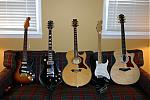Yup, CLF's on the line side of the switch. And yup, the cutout lids are not installed, just hanging on the bottom of the cutout......
Results 41 to 50 of 63
-
04-07-2014, 10:43 PM #41
-
 "It is not the critic who counts:The credit belongs to the man who is actually in the arena" Teddy Roosevelt
"It is not the critic who counts:The credit belongs to the man who is actually in the arena" Teddy Roosevelt
-
04-08-2014, 08:59 AM #43
-
04-08-2014, 05:42 PM #44
 Senior Member
Senior Member
- Join Date
- Mar 2009
- Posts
- 438
 Lordy!
Lordy!
I did a box 167s on a hanger arm, with a kicker arm, paralleled with an open temp bank on a stub pole shoe flies to the stub. It took for ever to transfer. Worked it out on hooks because little parking lot could only fit the digger. It took awhile. But that thing looks real busy!
-
-
04-08-2014, 05:48 PM #46
-
04-08-2014, 05:50 PM #47
 Senior Member
Senior Member
- Join Date
- Mar 2009
- Posts
- 438
-
04-08-2014, 08:14 PM #48
 Senior Member
Senior Member
- Join Date
- Feb 2007
- Location
- Ontario Canada
- Posts
- 1,284
-
04-10-2014, 03:22 PM #49
-
04-25-2014, 12:06 PM #50
 Member
Member
- Join Date
- Jul 2008
- Location
- Northern Illinois
- Posts
- 42
 Bonding guys wires and insulating neutrals?
Featured Sponsorr
Bonding guys wires and insulating neutrals?
Featured SponsorrHoly Cow, what a conversation. Let me add my 2 cents, and the reasons why I have 2 cents to add.
DO NOT bond your neutral to a down-guy or the anchor rod. A down-guy should be isolated from everything. It should have a head/body/and tail. The head is usually the fiber or glass rod at the top, the body is between the rod and the insulator near the ground which creates the tail. The guy should have the bottom 8 feet isolated to protect the people on the ground in case the guy breaks and makes contact with a live source. The people on the ground are supposed to be protected. Us lineman on the pole don't need protection from a guy because the guy should be isolated and we should know what we're doing.
If you bond the guy to your system neutral with no isolation points in the guy wire, you'll be turning your anchor rod into a ground rod. If you've ever pulled an old ground rod out while replacing a pole, you'll notice it's usually much shorter and now comes to a sharp point. That's the result of overvoltage going to earth at that point through the neutral and ground system. That's what a ground rod is supposed to do. If you ground your guy, the anchor rod will burn off from the anchor the same way. One of these days, and with any strain on it all, it will pull out of the ground and you lose your down-guy.
Let your guy and anchor be an anchor. Don't try to have them be a ground rod too.
The neutral is supposed to be grounded as often as you can. Your system is only as good as your neutral. Neutrals should be grounded every 600 feet and at every equipment pole. More often if you can. That's why most Wye systems are called "multi-grounded wye". Install a ground rod (meggered to less than 25 ohms) with minimum #6 copper and attach it to the neutral at every other pole if you can. While your at it, CLAMP the neutral directly to the pole. The objective is to GROUND the neutral, not insulate it from a ground potential. Those of you who do insulate the neutral on a spool will dead end it directly to the pole in the next span!! (and maybe even ground it to the down-guy and anchor rod?) That doesn't make any sense. I know it's a "current carrying conductor", but it's at ground potential and it's designed to be at ground potential, and we should do all we can to keep it at ground potential.
Those companies that clamp their neutrals to the pole don't do it so the linemen can use it as a pole bracket for equi-potential grounding either. They do it so their neutral is grounded as well as it can be 100% of the time. As a result of that good ground source, a lineman can use it for equi-potential grounding the 1% of the time he may be out there. At times, the pole can be a better ground than the #6 wire running down it. Team them together for a better ground. The more a neutral is grounded, and the better the grounds are, the safer your neutral will be and it will serve your system better.
Why insulate a neutral from the pole and then attach a down-ground wire to it that's stapled to the pole all the way down to the ground? What was the thinking behind that? Doesn't that make the insulator kind of useless?
Make your down-guys a down-guy and not a ground rod, but, ground your neutrals every chance you get. You're system will be better off for it!!





 Reply With Quote
Reply With Quote

